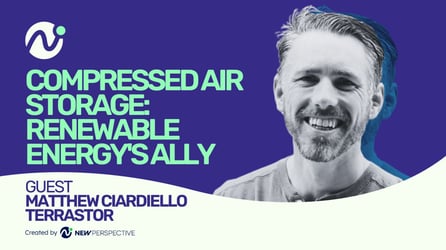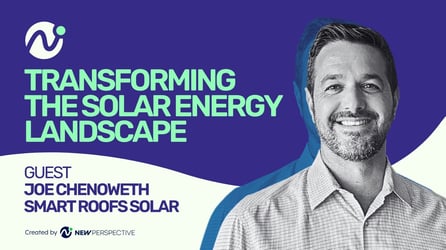Innovative Hydropower Solutions: Spotlight on Natel Energy
Natel Energy designs innovative hydropower turbines that ensure safe downstream passage for fish and other aquatic organisms. Their adaptable turbine technology can be integrated into various turbine types and sizes, making it applicable for both upgrading existing hydropower plants and constructing new, sustainable ones.
This FishSafe hydropower solution supports renewable energy generation, biodiversity, and is cost-effective.
🎥 Guest: Gia Schneider, co-founder and CCO of Natel Energy
🔗 Web: https://www.natelenergy.com
📝 Full episode transcript
Dunya: Hi Gia, welcome to our Green New Perspective Spotlight series.
Gia: Hi, how are you?
Dunya: Thanks so much for having me on. So, can you tell our audience a bit more about yourself and more about the company and what inspired you to start it?
Gia: Absolutely. So, I originally grew up in Texas and was a chemical engineer by training from MIT. One defining part of my childhood was that my father was very focused on climate change from a very early age. We grew up learning about climate change and the ways in which our energy system plays a real role in that challenge, as well as biodiversity.
My brother is an avid fisherman, and we spent a lot of time on the water. All of these experiences came together for me and my brother, who co-founded Natel, to focus on hydropower. Hydropower is an interesting, often forgotten renewable energy source that touches on many points that resonate deeply with us: climate, energy, water, and how we can combine these to create a more sustainable future.
Dunya: Can you tell me a bit more about the technology and the difference it's making in the industry and for the environment?
Gia: Sure. Hydropower has been around for about a century. In the US, we have about 100 GW of installed capacity today—about 80 GW of that is what we think of as dispatchable generation, and 20 GW is pump storage, which provides long-duration storage.
While hydro is a great energy source and provides the majority of the grid reliability services that keep our grid in the United States stable today, it faces some unique challenges:
-
Aging Fleet: The average age of hydro facilities in the US is 65 years, in Europe it's 55 years, and globally it's around 40 years. This presents challenges with aging equipment that needs to be upgraded to keep these generation resources online for another 60 years as part of the energy transition.
-
Biodiversity: Specifically, fish passage is a significant concern. Freshwater biodiversity has declined by about 75% since the 1970s, and while hydro isn't the only cause, it is a major driver. Approximately one in five fish do not survive passing through conventional turbines.
We saw an opportunity to apply advanced engineering principles to design high-performance, fish-safe turbines. We've developed a unique blade shape that combines a thick leading edge, which creates a pressure field to deflect fish and debris around the blades, with a forward swoop from hub to tip. This design results in over 98-99%, and in some cases 100%, demonstrated safe passage of fish through the turbine. The rest of the blade shape is optimized for traditional power performance metrics.
Dunya: Can you share some of the success stories over the last five years?
Gia: Certainly. We’ve progressed at a pretty fast pace:
- Early 2020: Computational fluid dynamics of our blade shape was completed.
- Spring 2020: Tested a megawatt-size blade in a fish passage laboratory.
- End of 2020: First project installed in Maine.
- Following Year: Second project installed in Oregon.
- 2012: First project installed in Austria, marking our entry into the European market.
We've also published four peer-reviewed papers in fisheries journals to document the science behind our fish passage technology, which is crucial for regulatory and environmental communities. Over the last two years, we've focused on bringing our technology to market at scale by partnering with established turbine manufacturers. We handle the design, innovation, testing, and demonstration, while our partners build the machines.
Dunya: What’s the role of hydropower in meeting 2035 Net Zero targets?
Gia: Hydropower plays a crucial role in achieving Net Zero targets by providing reliable, dispatchable power that complements intermittent renewable sources like wind and solar. For example:
-
United States: Rapid deployment of wind and solar over the last decade and a half has been impressive. However, to ensure round-the-clock reliable power, we need additional energy sources. Hydropower, along with natural gas, provides the flexibility required for grid reliability.
-
Europe and Canada: Similar patterns are observed where regions with hydropower and natural gas have successfully deployed wind and solar without compromising grid stability.
Looking forward to 2050, the industry faces two main challenges:
-
Upgrading Existing Fleet: We need to invest in upgrading the current hydro assets to keep them productive and functional, and to meet dispatch requirements that buffer the intermittency of wind and solar. Modern technologies like ours can enhance environmental performance and increase power output by 10-20% from existing assets.
-
Building New Capacity: It’s estimated that we need around 20 GW of new hydro capacity annually, which is currently not on track. Additionally, unlocking new potential from existing non-power water infrastructure could add about 13 GW of new capacity in the US alone. The raw resource for new builds is upwards of 65 GW, though this depends on technical feasibility.
Dunya: What needs to change to overcome these challenges?
Gia: To overcome these challenges, several changes are necessary:
-
Upgrading Existing Fleet: Focus on modernizing current hydro facilities to keep them online and improve their efficiency and environmental performance.
-
Unlocking New Capacity: Utilize existing non-power water infrastructure to add new hydro capacity. This involves identifying suitable sites and ensuring they meet technical and environmental standards.
-
Scaling Up New Builds: Invest in developing new hydro projects to meet the estimated 20 GW annual requirement. This requires streamlined regulatory processes, increased funding, and collaboration with industry stakeholders.
Dunya: If our audience wants to learn more about Natel, where can they do that?
Gia: Absolutely. The easiest way is to visit our website at natelenergy.com. There, you can find information about our technology, access our published papers, watch videos of our test turbines in action, and learn more about our work. Feel free to get in touch with us at info@natelenergy.com.
Dunya: Thank you for watching our Green New Perspective Spotlight series. If you like our content, please consider subscribing to our social media channels and following our podcast on your favorite streaming platform. Thanks!
🎧 Subscribe to our podcast
- Spotify: https://bit.ly/3PSWIyI
- Apple Podcasts: https://bit.ly/3RvlHte
- YouTube: https://bit.ly/3RDzkXg
- Deezer: https://bit.ly/3PvQaof
- Amazon Music: https://bit.ly/3PQlijS
💬 Follow GNP on Social
Host & Co-Producer: Dunja Jovanovic
Executive Producer: Marko Bodiroza
Creator: Nathan Harris
Video & Sound Editor: Marija Davidoski



